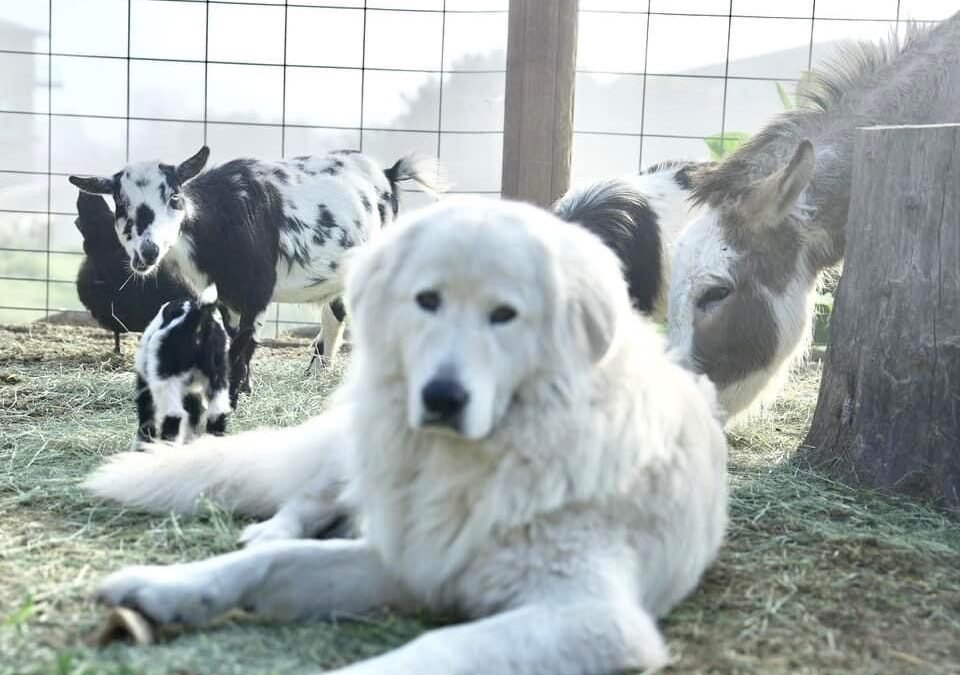The answer to question one is “Slowly and carefully.” The answer to question two is answer one. (Move slowly and carefully when you bring your new dog home. And buy your puppy from the right breeder, of course.) It’s much easier to prevent an unwanted behavior from happening in the first place through management and good antecedent arrangement than to stop an undesirable behavior after it’s started.
What’s more, if you don’t set your new Livestock Guardian Dog up for success through environmental management and proper supervision, you could be setting them up for failure. Livestock Guardian Dogs have the instincts to protect livestock and less of a tendency to chase or harass animals like herding or other types of dogs. However, as living beings, they can still learn inappropriate behaviors due to poor management, especially when young and immature. (Livestock Guardian Dogs are generally not mature until around 2 years old.)
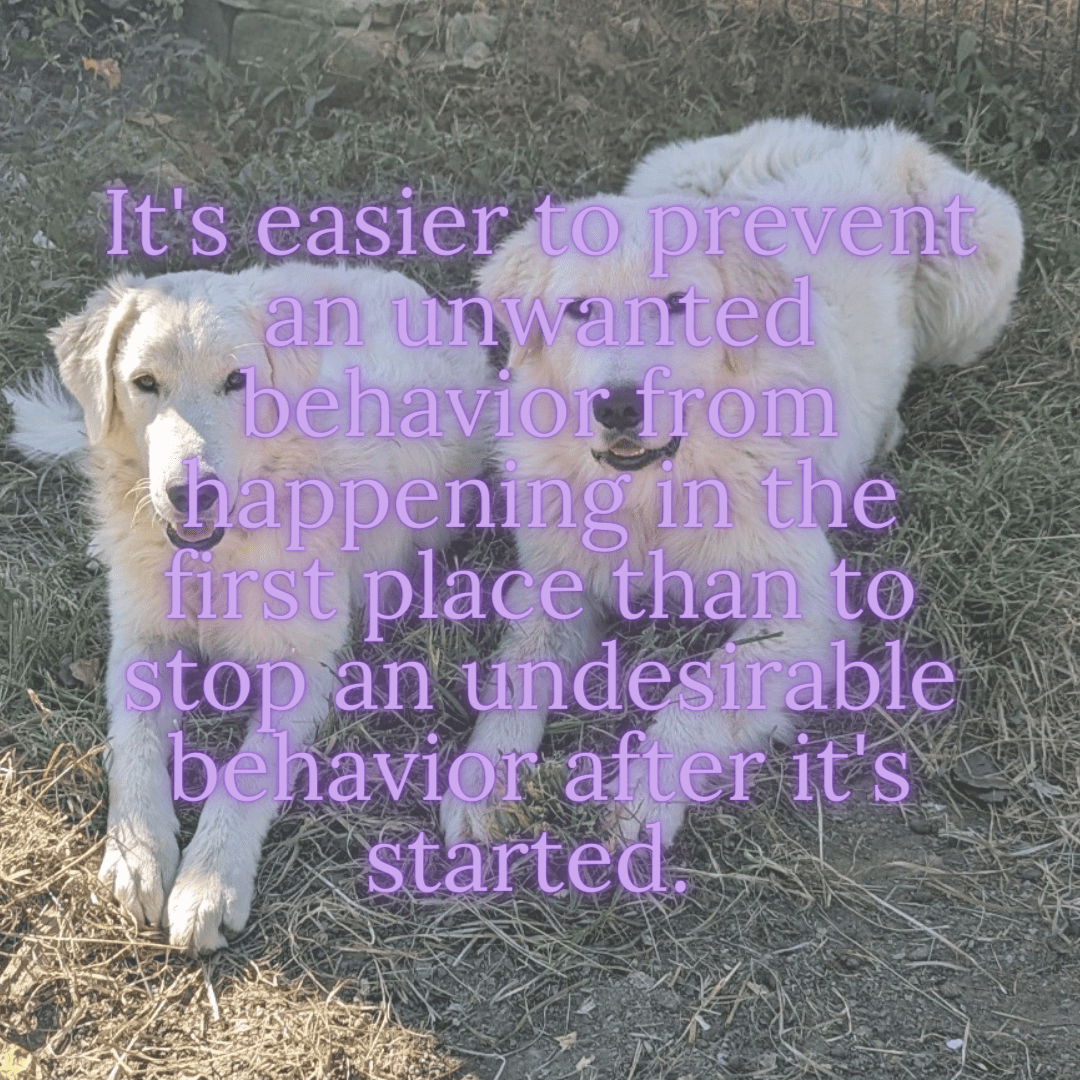
Human Mistakes Can Cause LGDs to Fail and Livestock to Get Hurt
When dogs chase or harass livestock, they get a dopamine rush, much like a gambler or a kid playing video games. This makes it impossible for them to use good judgment or to stop themselves. They will only stop if the livestock manages to evade them if they get tired or are interrupted by a human.
Suppose you bring your new puppy or young dog home, put it in with your livestock, and leave them alone. In that case, you rely on the animals to work things out without your help. You are gambling with your dog’s training and your livestock’s well-being and safety. That makes about as much sense as expecting a room full of toddlers to supervise themselves.
Chasing livestock is a self-rewarding behavior due to the dopamine rush the dog gets, and it’s highly addictive because of this dopamine effect. (It’s like dog crack.) The more a dog chases, the more it wants to chase. If left unchecked, chasing can become a motor pattern and a habit that may be very hard (if not impossible) to outgrow. (The same is true of behaviors like killing chickens. A few accidental bird deaths won’t ruin an LGD, but a pattern of this may be difficult to break later.)
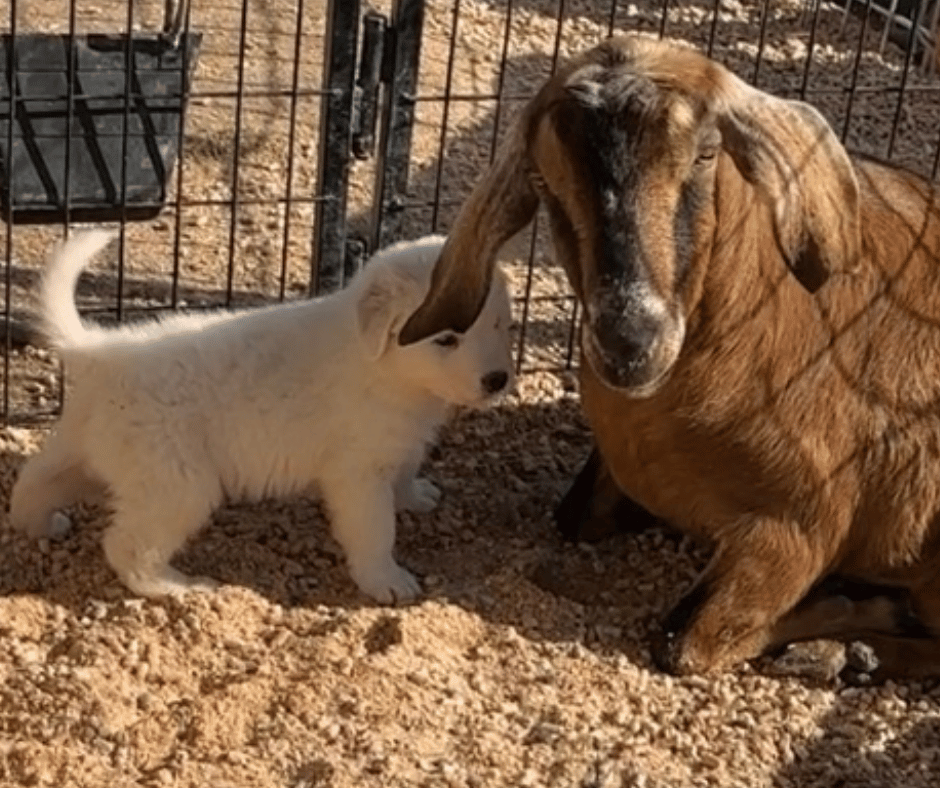
The Two-Part Formula for Producing Outstanding Livestock Guardian Dogs
There are two parts to the equation for having a livestock guardian dog that’s safe with livestock. First, you should only buy an LGD from a breeder with a very intensive livestock socialization program for their puppies. This means the puppies are with livestock as early as possible, at least by 3 weeks or so. Eight weeks is almost too late, and a breeder who waits until the puppies are 3-4 months old to put them with livestock or expects the new puppy owners to do it is raising companion dogs, not Livestock Guardian Dogs.
Such a dog might eventually be a fair Livestock Guardian Dog, with a LOT of work and training on the owner’s part, but they will never be great. (And who wants a fair LGD?) Most new Livestock Guardian Dog owners are not equipped to train a puppy who had such a poor start, so do yourself a favor and buy a correctly socialized puppy in the first place.
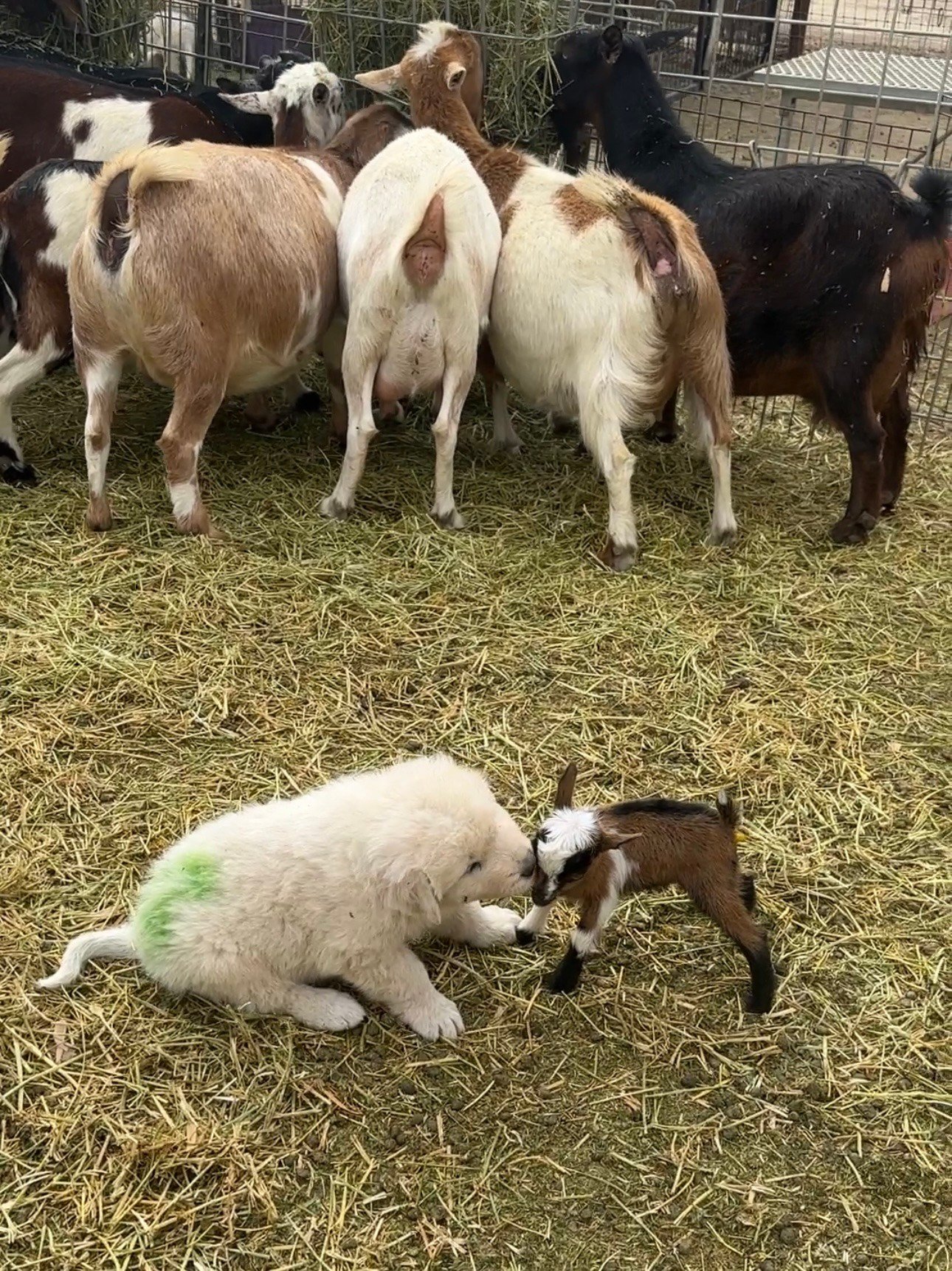
Your Role as Owner and Trainer
The second part of the equation is your role. You must do your part to set your new Livestock Guardian Dog up for success with your livestock. Even if the breeder did a fantastic job socializing the puppies, they must still be fully trained and mature before becoming Livestock Guardian Dogs. Until then they are LGDs in training. They will need management and further training from you. Adolescent dogs (about 4 months to 2 years) still need to learn what’s appropriate and not, and lack of supervision can get them into trouble. We supervise human children until we know they can make responsible choices. Dogs are no different.
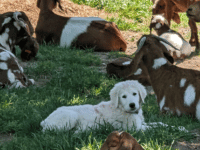
The Importance of Proper Acclimation with Livestock
Acclimating young Livestock Guardian Dogs to their new livestock isn’t just about safety; it’s about setting the puppy up to win and ensuring dogs and stock alike feel comfortable with the arrangement. Proper acclimation prevents undesirable behaviors such as chasing, which can lead to unnecessary stress and injuries for the stock and bad habits for the dog. Following these steps will ensure your LGDs are well-prepared to protect their charges without causing you a lot of extra work or financial losses due to injured stock.
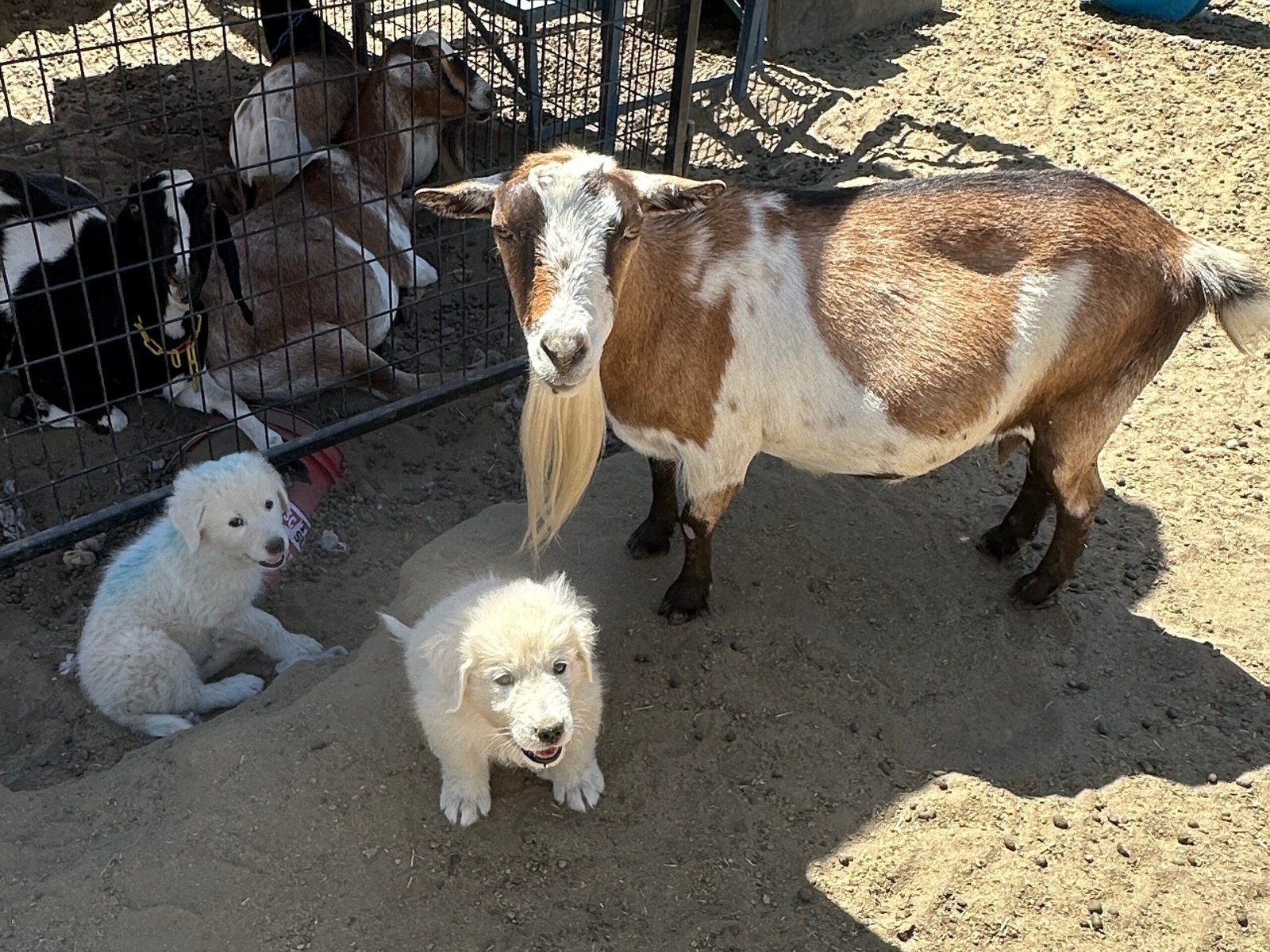
Step-by-Step Guide to Acclimating LGDs to New Stock
Start with Side-by-Side Acclimation
Even if your puppy was raised with livestock, it needs time to adjust to new animals, and the animals need to adapt to your dog. If your livestock have never had a positive experience with dogs, they will likely think you’ve lost your mind about bringing a predator into their midst! (Even LGDs are technically predators; trust me, prey animals know this instinctually.)
If your livestock have had exposure to trustworthy Livestock Guardian Dogs or other well-mannered, safe dogs, then your introduction will be easier. But every dog is a new dog to your livestock. Every goat, sheep, chicken, etc., is new to your new Livestock Guardian Dog, so you must let them get to know each other before expecting them to be comfortable together.
Begin by placing the young dog in a fenced area adjacent to the livestock. (This can be a permanent or temporary set-up.) This way, they can observe each other’s behavior without direct interaction. This side-by-side acclimation helps the dog and the livestock get used to each other’s presence.

I need to clarify that when I say to put the puppy in an area adjacent to the livestock, I do not mean something like a barn stall or a dog kennel. That is okay for a day or two, but if your puppy is over 8 weeks old, they will need space to run, play, and burn off energy. Otherwise, they won’t be able to behave calmly with the livestock, and your job of training them will be very difficult. If you have a big and small space adjacent to each other, you should put the livestock in a smaller area and give the dog the bigger portion. It would be better to confine your free-range chickens until the puppy is trained than to cause stress to your dog by too much confinement.
You can feed the livestock near the pup to encourage them to come close to the fence. The pup can see and smell the animals, watch all the strange ways they move, and hear the funny sounds they make. This is especially helpful if you have a different species from what the breeder had or more flighty, bouncy animals.

Over time, your livestock will become more relaxed with the pup’s presence, and the dog will become desensitized to the sight, sound, and behavior of the animals. How long this will take depends on a lot of factors, including how your puppy was socialized (or not) by the breeder, the temperament of your stock, and your dog’s “L.E.G.S.” (All dogs are made up of their individual “L.E.G.S.” – Learning, Environment, Genetics, and Self. To learn more about L.E.G.S. Applied Ethology, click on the button below.)

Video - What to Do When You Bring Home Your New Livestock Guardian Dogs
The video below was made for a client who bought two pups from me to guard her goats. She was not sure how to acclimate the pups into the herd. I decided to make a video explaining the process I recommend. These tips should be helpful to anyone who is adding new LGDs to their farm. Enjoy!
Properly Introducing Your LGD to Your Livestock
Once the dog and livestock both seem comfortable with each other, it’s time for supervised interactions. Allow the dog to enter the livestock area while you closely monitor their behavior. Keep these sessions short initially, gradually increasing the time as your dog learns to behave appropriately around the livestock.
In the beginning, you should have the dog on a leash or long line so you can control the situation and quickly remove the dog if things aren’t going well. (I like to train young dogs with a 15′ long line.) You can proceed to off-leash training sessions once things are going well on leash. You can always return to using the leash or long line if needed.

Use Calm, Easygoing Livestock
When introducing a young dog to livestock, choose calm and easygoing animals. Skittish goats or other animals can encourage undesirable behaviors (chasing) in the dog. Overly aggressive livestock can cause the puppy to become defensive or aggressive and develop a negative association with stock. Calm animals will help the dog learn to remain calm and quiet and enjoy being with the livestock.
I always encourage people to remember that when you first bring a new puppy or dog home, their job is not to guard all your livestock immediately. It’s your job to train your puppy; carefully chosen stock can help make that job more manageable, while the wrong stock can make it more challenging.
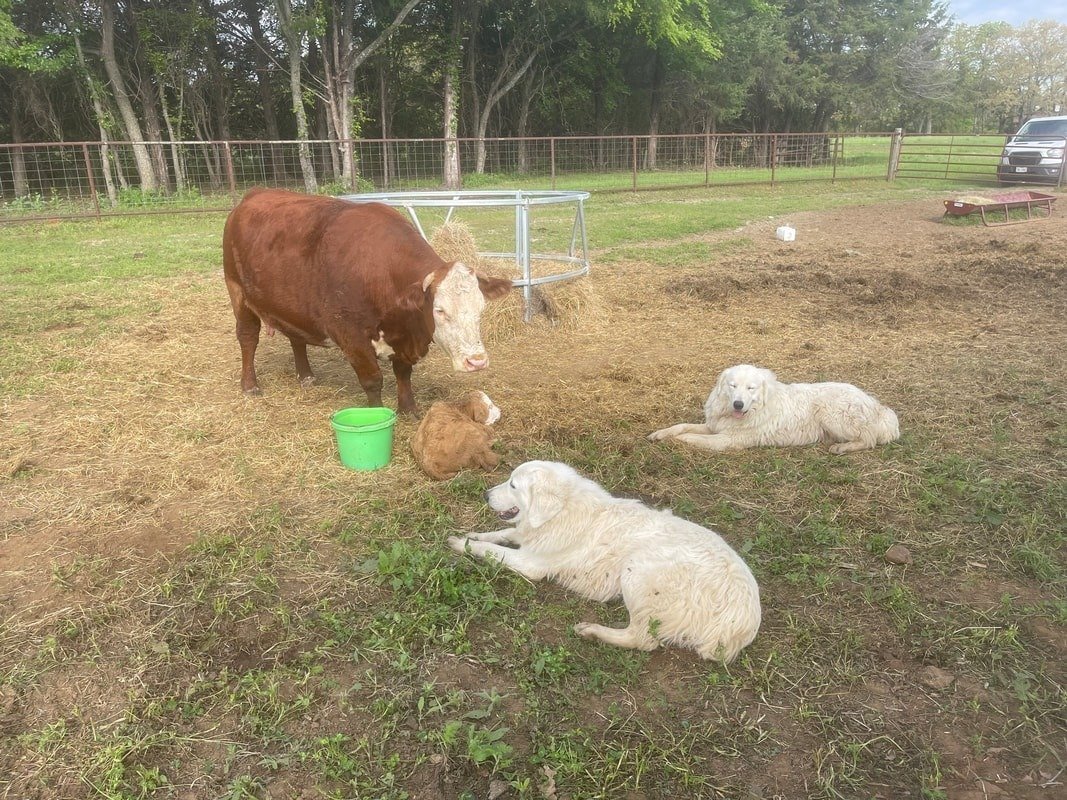
I have many goats, horses, four kinds of poultry, and other animals on my farm. However, not all of them are appropriate for puppy training. Some are good at one stage or another. Some are good only as side-by-side acclimation projects, and some are only good around fully mature dogs. I am cautious about what stock I use to train my puppies and adolescent dogs. My favorite goats are the ones that I know are great puppy trainers. They are worth their weight in gold.
You may need to choose just a few animals to use as puppy trainers and save the rest for when your dog is more mature. That’s not what most new LGD owners expect when they bring home a new Livestock Guardian Dog. They are getting the dog to guard the stock for them. But that MUST come at the right time if you want your dog to be successful and your livestock to be safe. I promise you your patience will pay off.
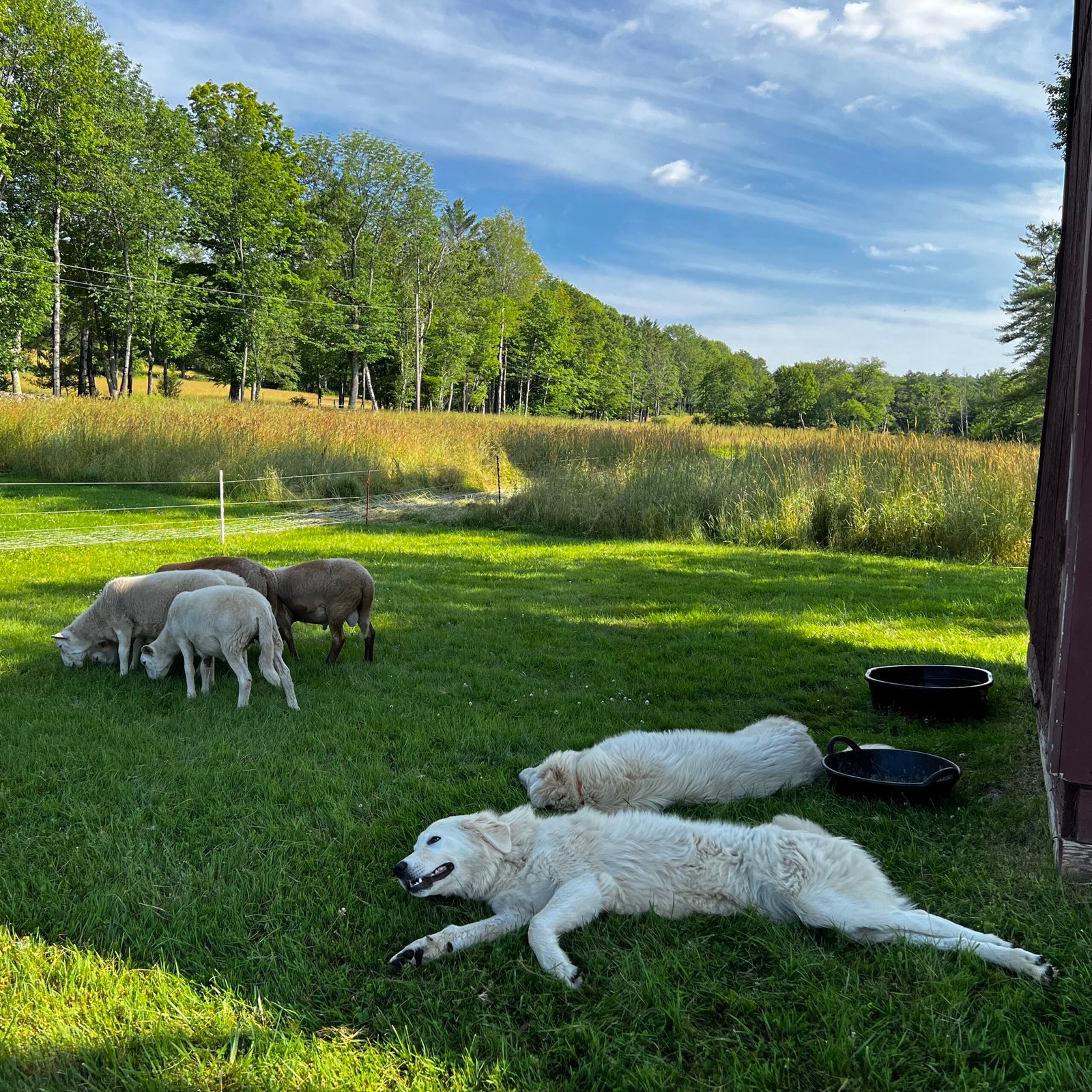
Prevent Chasing Behavior
Preventing chase behavior is crucial. Young dogs can quickly develop a habit of chasing livestock, which can lead to injuries, stress, and even death. If your dog is inclined to chase, immediately intervene and go back a step. (Go back to the lead if you’re off lead, or give the animals more side-by-side time to acclimate to each other.) Consistent supervision and positive training are vital in preventing bad habits from forming.
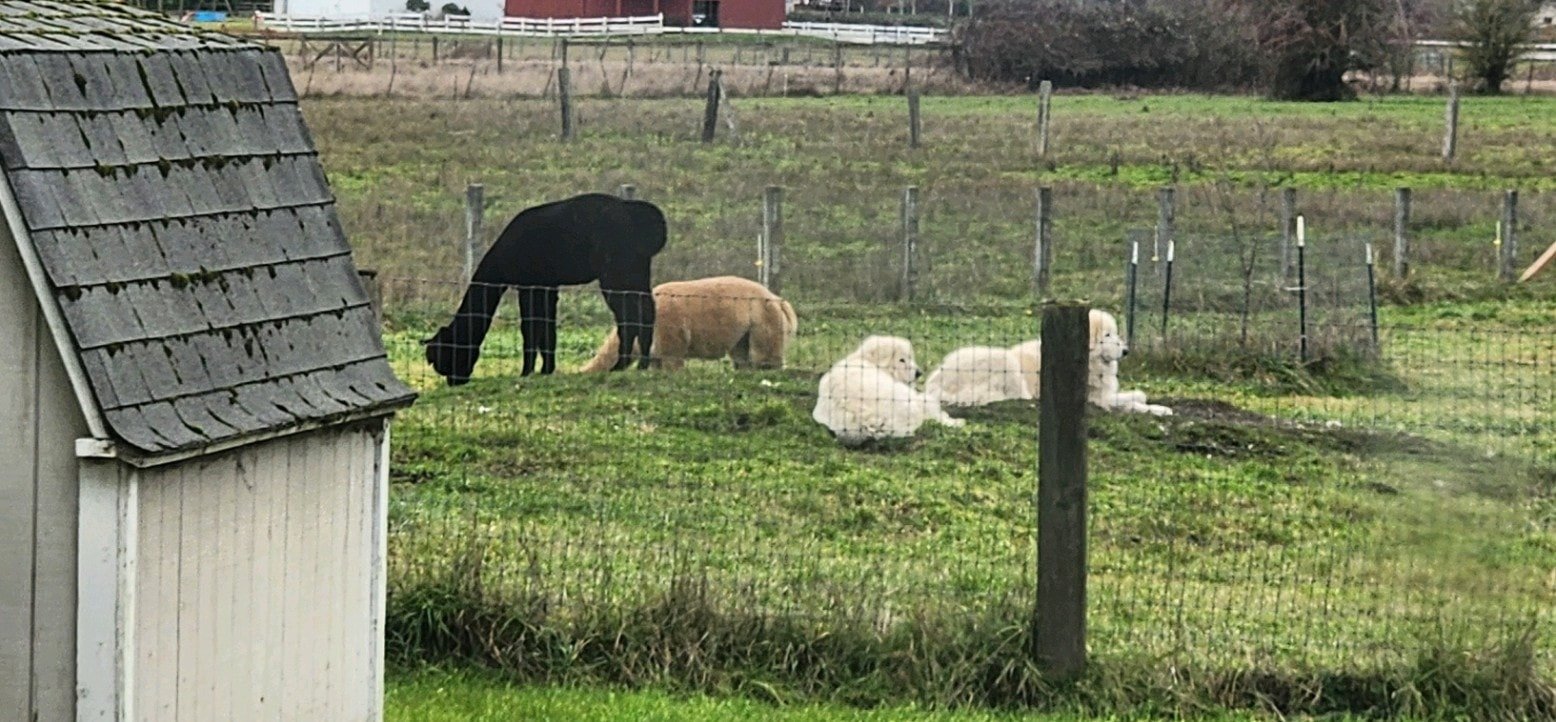
Use Positive Reinforcement to Help the Dog Know he's on the Right Track
Positive reinforcement (clicker or marker training) is your secret weapon in training your Livestock Guardian Dog to behave appropriately with livestock. Proper training of Livestock Guardian Dogs is not about “correcting” or stopping behavior. It’s about teaching them what you want them to do. (It has been scientifically proven that dogs learn better and faster from positive reinforcement and that aversive training methods hinder learning.) A step-by-step explanation of that process is beyond the scope of this post, but I will write about it in a future post.
You’ll need to learn clicker training concepts and apply them to your livestock training sessions. Then, you will mark (click) and reinforce (give yummy treats) when your Livestock Guardian Dog behaves calmly and quietly with the stock. (You can use a marker word like “good” if you wish, but the clicker is more effective, especially when training a new behavior.)
You can learn about clicker training through books. Still, I suggest all Livestock Guardian Dog owners take the Karen Pryor Academy Dog Trainer Foundations course. In this course, you will learn the basics of clicker training and why it’s such a powerful tool in dog training. Then, once you know how to train your dog through clicker training, you can incorporate that into your livestock training time.
You will want to click and reinforce your dog for the calm, quiet behavior you see that you want more of while ignoring and redirecting them from the unwanted behavior. No corrections are necessary, and this method works much better. It’s also a great way to bond with your new dog and fun for dogs and humans alike!
Provide Positive Role Models When Possible
Having older, well-trained dogs as role models can significantly aid the training of young LGDs. These experienced dogs will demonstrate appropriate behavior and help the young ones learn the ropes. Pairing a young dog with a mature, reliable guardian can accelerate their learning process.
Contrary to common myth, most older Livestock Guardian Dogs don’t train young pups by “correcting” them, and this shouldn’t be your goal. A puppy bullied by an older dog may become fearful, aggressive, or both. The best puppy trainers are patient and gentle with puppies, excellent with livestock, and lead by example, not force.

A Working Partner
If you don’t have an older Livestock Guardian Dog to help mentor your puppy, that’s okay. Most new LGD owners don’t; we all have to start somewhere. Suppose your breeder does a proper job of socializing puppies and keeps them until at least 3-4 months before sending them to new homes, and you’ll be ahead of the game. In that case, the pups will have already learned much from their parents, other mentor dogs, and carefully selected livestock.
More important than an older mentor dog is a working partner (Livestock Guardian Dog) and companion close in age to your puppy or dog. Livestock Guardian Dogs always work best in pairs or teams, but it needs to be an appropriately matched team. Usually, two dogs close in age will do best together because they have similar energy levels and developmental stages. Not all older dogs like puppies and can get grumpy with them. The puppy may be bored with only an adult dog as a companion. Having a partner that matches their energy and interests is better for them.
In most cases, this will result in the pups playing more with each other and less roughhousing and chasing of the stock. You’ll still need to supervise them in case they decide to tag team chasing the goats or chickens, but at least if you do need to temporarily separate the dogs from the stock, they will have a playmate. A happy dog is a better guardian; single dogs are rarely as happy as dogs with a working LGD partner.
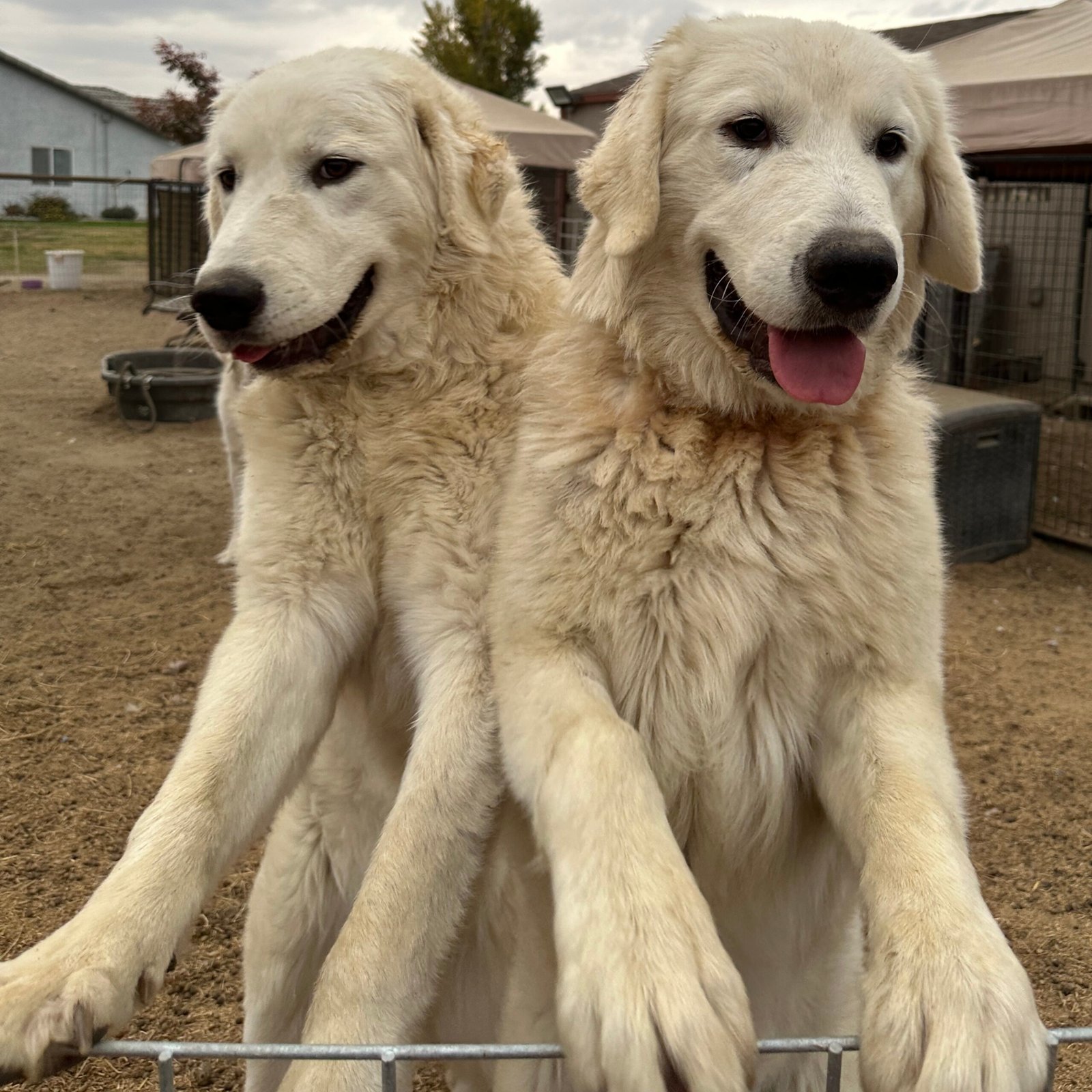
Separate Feeding Times for Stock and LGDs
Feeding times can be a source of conflict between Livestock Guardian Dogs and livestock. Allowing stock to steal dog food is bad for several reasons. First, dog food is unhealthy for most livestock who are vegetarians and should not eat animal products. Second, dog food is too expensive to feed livestock. (Compare a pound of dog food to a pound of hay or grain. Dog food is much more costly.)
Most importantly, allowing livestock to steal food from your LGDs can lead to resource guarding in your dogs. Resource guarding comes from a place of insecurity in dogs, and not much can make a young dog feel more insecure than greedy goats or sheep gobbling up all their food. If this gets really bad, the dog could become aggressive towards the stock even outside of feeding time—not your goal in getting a Livestock Guard Dog!
Feed your dogs in a separate, secure area away from the livestock to prevent resource guarding and other issues. This ensures the animals don’t steal the dogs’ food and helps maintain a peaceful environment.
Some Livestock Guardian Dogs are uncomfortable being watched while they are eating. In this case, you should use a visual barrier as well as a physical one to separate the LGD from the livestock. This can be as simple as a tarp of shade cloth hung on a fence between the dogs and the stock in the dog’s feeding area.
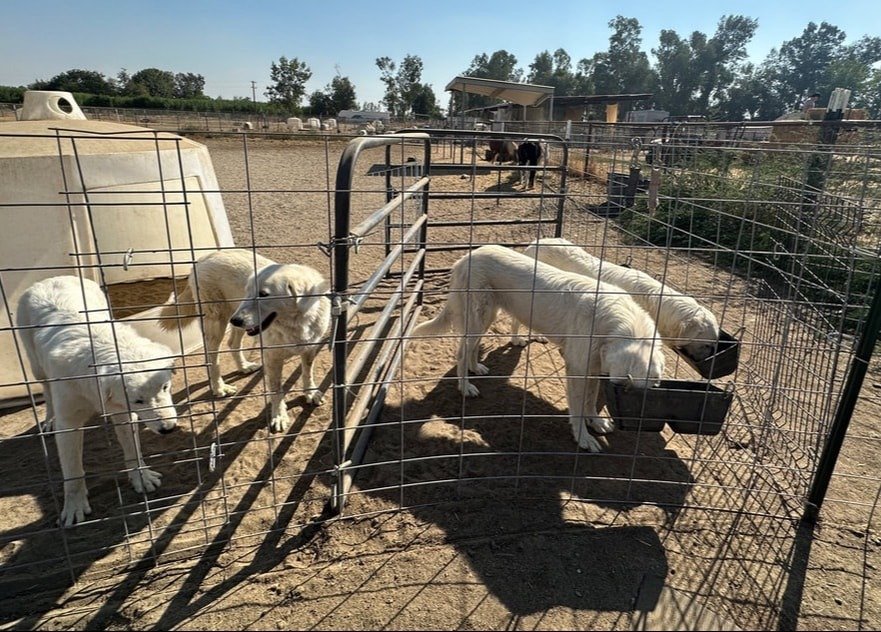
Real Life Example: Diana's Journey
Below is a video of me having a training session with Diana, a young dog with a history of chasing livestock. I acquired Diana from another breeder when she was three months old, so she missed out on my early socialization program. This was before I understood the impact of the critical socialization period (which happens in the first 12 weeks or so) on dogs. Training Diana has been difficult, but I have learned much from her.
Diana was very rough with livestock and aggressive with other dogs from a young age. She would attack adult dogs and puppies alike, and constantly chased and harrassed the goats.
The problem was that I had never encountered a dog like her and was unprepared for her behavior. I knew the genetics were good, so there was no concern there. My mistake was that I assumed that all Maremma breeders train and socialize their puppies the way I do. I thought if I managed her the way I do the pups I bred, I would get the same results. Boy, was I wrong!
It’s safe to say Diana is the most challenging dog I’ve ever owned. More than one person (including a prominent Livestock Guardian Dog trainer) advised me to put her to sleep. But Diana is a very sweet-natured dog with humans (she loves attention), and her issues are not her fault. I knew she had potential as a companion dog and maybe as an LGD in the right home. The problem was that I knew no such home and couldn’t ethically place her with an inexperienced owner. So, I had no choice but to keep her and try to rehabilitate her through management and positive training.
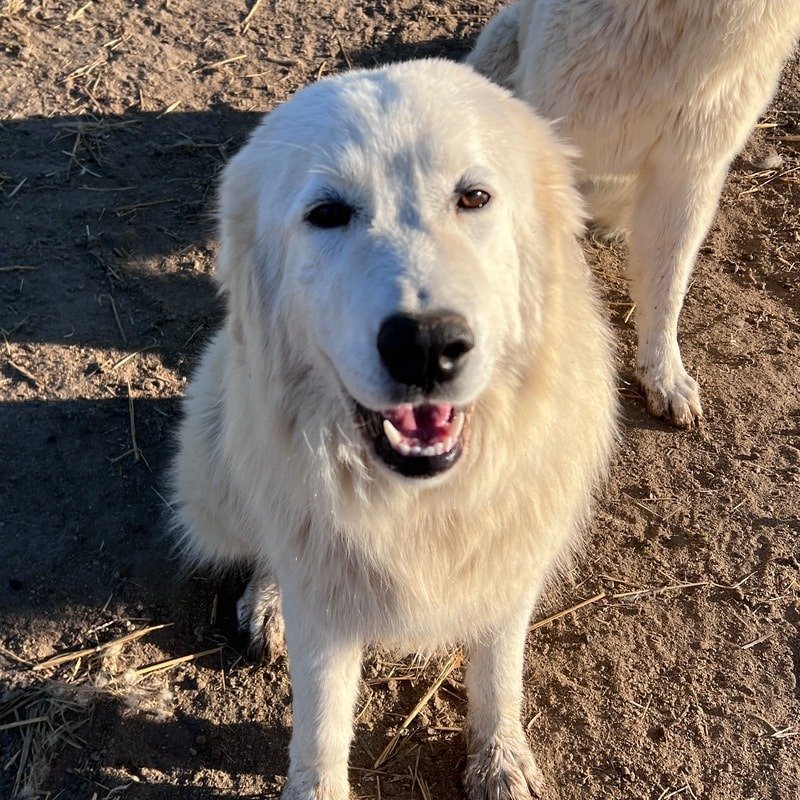
I had to carefully choose what animals or dogs Diana was with, and at times, she was not safe with any livestock. She could only be trusted with bucks and horses; even with them, she wasn’t great. But she couldn’t hurt them like she would have hurt a smaller goat or a bird.
She was tricky to pair with other dogs. Females are absolutely out as it would result in an intense fight. She isn’t good with puppies and she will even pick a fight with a male dog twice her size. She’s a small dog, and I don’t want her to get hurt, so there was a lot of trial and error in finding a dog that worked well with her. The best one has been Pegaso because he is very mellow and won’t fight with any dog.
Because I didn’t want Diana to develop bad habits, she received primarily side-by-side and supervised interaction with the livestock, as explained in this article and the video. This has allowed her to mature without building motor patterns of chasing and harassing stock.
I also had her spayed shortly before she turned two. There isn’t a genetic component to her behavior, but I decided she didn’t meet my criteria for a breeding dog. I also hoped spaying her would help her behavior. It took a while, but it did help some. At least there are no more raging hormones to deal with, and I can pair her with an intact male dog without worry.

As you will see in the video, Diana has come a long way and improved her behavior so much. This is because she has been prevented from “practicing” bad habits while her brain caught up with her emotions. Most dogs don’t take three years to reach this stage, but Diana didn’t get the memo. She doesn’t yet meet my definition of a mature, trustworthy adult Livestock Guardian Dog, but she’s getting close. And I’m happy I didn’t listen to the naysayers and allowed Diana to show her potential in her own time.
So whether you have a typical young Livestock Guardian Dog with occasional bouts of the Zoomies or a more challenging case like Diana, take heart. With the tips in this post and this video, even you can help your dog reach its full potential as a Livestock Guardian.
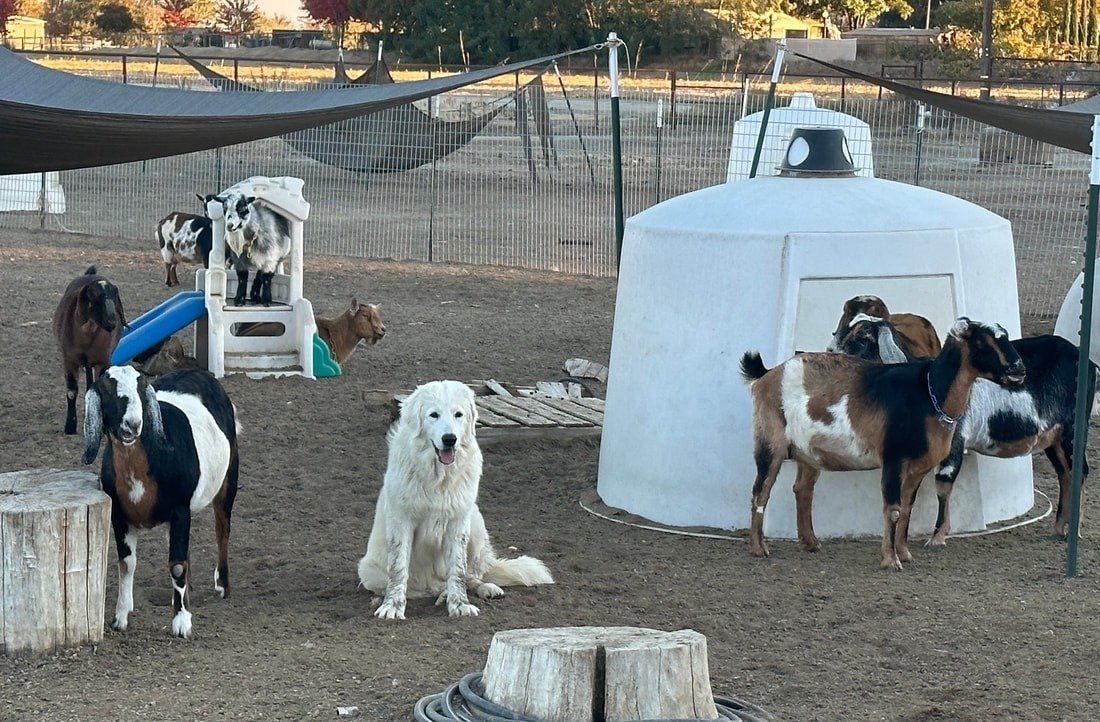
Join the Prancing Pony Farm Family
At Prancing Pony Farm, we’re committed to helping people keep their livestock safe through the use of Livestock Guardian Dogs. To do this, they need appropriately trained LGDs. We want to make LGD ownership and training as joyful and stress-free as possible.
There are three ways we can help you:
Sign up for our free email newsletter, where you will receive free content like this post and video right to your inbox.
Option 2
If you already own an LGD dog that you need help with, our Livestock Guardian Dog virtual training and consulting services can help! As a longtime Maremma sheepdog breeder, farmer, positive reinforcement dog trainer, and certified Family Dog Mediator, I can help get you and your dog on the track to success and a happier, more peaceful relationship.
Option 3
If you want the best Livestock Guardian Dog money you can buy, with unparalleled lifetime breeder support and professional training services included, then look no further than a Prancing Pony Maremma Sheepdog. We know our puppies are more expensive than most other breeders, but that’s because they are worth it.
When you consider the quality of our dogs and the fact that you won’t be left to figure out the training on your own, or need to pay extra for training services, our Maremmas are actually the best value available.

